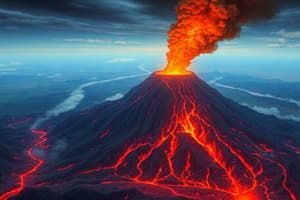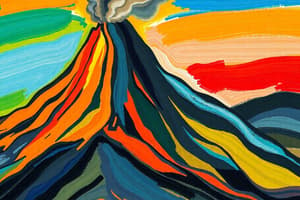Podcast
Questions and Answers
What is the primary lava type associated with composite volcanoes?
What is the primary lava type associated with composite volcanoes?
- Perlite lava
- Basaltic lava
- Andesitic lava
- Rhyolitic lava (correct)
Shield volcanoes typically have explosive eruptions.
Shield volcanoes typically have explosive eruptions.
False (B)
Name one example of a composite volcano.
Name one example of a composite volcano.
Fujiyama, Mt. Mayon, or Kanlaon
The shape of a shield volcano is described as _____ shaped.
The shape of a shield volcano is described as _____ shaped.
Match the following volcano types with their characteristics:
Match the following volcano types with their characteristics:
Which characteristic is true about lava domes?
Which characteristic is true about lava domes?
The viscosity of basaltic lava is higher than that of rhyolitic lava.
The viscosity of basaltic lava is higher than that of rhyolitic lava.
What is magma primarily composed of?
What is magma primarily composed of?
Lava flows faster on gentle slopes than on steep slopes.
Lava flows faster on gentle slopes than on steep slopes.
What is the term used for a mound of lava growing inside a crater?
What is the term used for a mound of lava growing inside a crater?
A _____ is a flow of volcanic debris that can be classified as primary or secondary.
A _____ is a flow of volcanic debris that can be classified as primary or secondary.
Match the types of volcanic gases to their chemical formulas:
Match the types of volcanic gases to their chemical formulas:
Which type of magma has the highest gas content?
Which type of magma has the highest gas content?
Basaltic magma has a higher viscosity than rhyolitic magma.
Basaltic magma has a higher viscosity than rhyolitic magma.
What is primarily responsible for increasing the flow ability of magma?
What is primarily responsible for increasing the flow ability of magma?
The temperature range of andesitic magma is between ____ and ____ degrees Celsius.
The temperature range of andesitic magma is between ____ and ____ degrees Celsius.
Match the magma types with their corresponding silica content:
Match the magma types with their corresponding silica content:
What factor allows magma to have varying explosion potential?
What factor allows magma to have varying explosion potential?
All magma types have the same gas content.
All magma types have the same gas content.
Which magma type is considered the least explosive?
Which magma type is considered the least explosive?
The major gas found dissolved in magma is ____.
The major gas found dissolved in magma is ____.
What characteristic is least associated with basaltic magma?
What characteristic is least associated with basaltic magma?
Which type of volcanic eruption is characterized by continuous ejection of magma and gas?
Which type of volcanic eruption is characterized by continuous ejection of magma and gas?
Hawaiian eruptions are the most violent type of explosive eruptions.
Hawaiian eruptions are the most violent type of explosive eruptions.
What is the property of a liquid that describes its resistance to flow?
What is the property of a liquid that describes its resistance to flow?
The ___________ of magma decreases with temperature.
The ___________ of magma decreases with temperature.
Match the type of volcanic eruption with its characteristic:
Match the type of volcanic eruption with its characteristic:
Which volcano is an example of a submarine volcano?
Which volcano is an example of a submarine volcano?
High silica content magmas are more fluid than low silica content magmas.
High silica content magmas are more fluid than low silica content magmas.
Name the eruption type characterized by the formation of volcanic bombs and cinder cones.
Name the eruption type characterized by the formation of volcanic bombs and cinder cones.
Plinian eruptions can produce eruption columns that reach heights of ___________ to ___________ km.
Plinian eruptions can produce eruption columns that reach heights of ___________ to ___________ km.
What factors affect the nature of a volcanic eruption?
What factors affect the nature of a volcanic eruption?
Which of the following volcanoes has had recorded volcanic activity in the last 600 years?
Which of the following volcanoes has had recorded volcanic activity in the last 600 years?
Mt.Apo is classified as an active volcano.
Mt.Apo is classified as an active volcano.
Name one volcano considered to be inactive.
Name one volcano considered to be inactive.
A ______ eruption is driven by the heat from surrounding rocks and produces ash, but does not include new magma.
A ______ eruption is driven by the heat from surrounding rocks and produces ash, but does not include new magma.
Match the following volcanoes with their classification:
Match the following volcanoes with their classification:
What is primarily responsible for the explosive character of magmas?
What is primarily responsible for the explosive character of magmas?
Phreatomagmatic eruptions occur when new magma interacts with water.
Phreatomagmatic eruptions occur when new magma interacts with water.
What is the primary component responsible for phreatic eruptions?
What is the primary component responsible for phreatic eruptions?
Volcanoes that have not erupted for a long time but may do so in the future are classified as __________.
Volcanoes that have not erupted for a long time but may do so in the future are classified as __________.
Which of the following is a characteristic of magma?
Which of the following is a characteristic of magma?
Flashcards
Composite Volcano
Composite Volcano
A tall, cone-shaped volcano formed by layers of lava and ash, with explosive eruptions and a central vent or multiple vents.
Rhyolitic Lava
Rhyolitic Lava
A type of lava found in composite volcanoes, with high silica content and low iron and magnesium, making it thick and slow-flowing.
Shield Volcano
Shield Volcano
A huge, gently sloping volcano with a central vent, formed by repeated eruptions of fluid, basaltic lava flows.
Basaltic Lava
Basaltic Lava
Signup and view all the flashcards
Lava Dome
Lava Dome
Signup and view all the flashcards
Viscosity
Viscosity
Signup and view all the flashcards
Active Volcanoes
Active Volcanoes
Signup and view all the flashcards
Dormant Volcanoes
Dormant Volcanoes
Signup and view all the flashcards
Extinct Volcanoes
Extinct Volcanoes
Signup and view all the flashcards
Magma
Magma
Signup and view all the flashcards
Phreatic Eruption
Phreatic Eruption
Signup and view all the flashcards
Phreatomagmatic Eruption
Phreatomagmatic Eruption
Signup and view all the flashcards
Volcanic Eruption
Volcanic Eruption
Signup and view all the flashcards
Gas in Magma
Gas in Magma
Signup and view all the flashcards
Volcano
Volcano
Signup and view all the flashcards
Magma Chamber
Magma Chamber
Signup and view all the flashcards
Volcanic Blast
Volcanic Blast
Signup and view all the flashcards
Dome Growth
Dome Growth
Signup and view all the flashcards
Lahar
Lahar
Signup and view all the flashcards
Magma Temperature and Viscosity
Magma Temperature and Viscosity
Signup and view all the flashcards
Magma Composition and Viscosity
Magma Composition and Viscosity
Signup and view all the flashcards
Dissolved Gases and Viscosity
Dissolved Gases and Viscosity
Signup and view all the flashcards
Strombolian Eruption
Strombolian Eruption
Signup and view all the flashcards
Plinian Eruption
Plinian Eruption
Signup and view all the flashcards
Hawaiian Eruption
Hawaiian Eruption
Signup and view all the flashcards
Vulcanian Eruption
Vulcanian Eruption
Signup and view all the flashcards
Submarine Eruption
Submarine Eruption
Signup and view all the flashcards
Volcanic Water Source
Volcanic Water Source
Signup and view all the flashcards
What is viscosity?
What is viscosity?
Signup and view all the flashcards
What is rhyolitic magma?
What is rhyolitic magma?
Signup and view all the flashcards
What is basaltic magma?
What is basaltic magma?
Signup and view all the flashcards
How does gas affect magma?
How does gas affect magma?
Signup and view all the flashcards
How does gas content relate to eruption type?
How does gas content relate to eruption type?
Signup and view all the flashcards
How does gas content vary across magma types?
How does gas content vary across magma types?
Signup and view all the flashcards
How does silica content affect magma viscosity?
How does silica content affect magma viscosity?
Signup and view all the flashcards
How does temperature impact magma viscosity?
How does temperature impact magma viscosity?
Signup and view all the flashcards
What is the temperature range of rhyolitic magma?
What is the temperature range of rhyolitic magma?
Signup and view all the flashcards
What is the temperature range of basaltic magma?
What is the temperature range of basaltic magma?
Signup and view all the flashcards
Study Notes
Volcanoes
- Volcanoes are vents in Earth's surface where molten rock and gases erupt from the interior.
- They are different from other mountains, formed by their own eruptive products (lava, volcanic bombs, ash).
- A volcano's shape is typically conical, built around a vent that connects with reservoirs of molten rock.
Parts of Volcanoes
- External Parts
- Base: The lowest part supporting the volcano.
- Slope: The slant or inclination of the volcano.
- Summit: The peak or highest point.
- Internal and External Parts
- Lava/rocks: Molten rock ejected from a volcano
- Ash cloud: A cloud of ash formed by volcanic explosions.
- Crater: The mouth of a volcano surrounding the vent.
- Caldera: A volcanic crater formed when part of a crater collapses.
- Conduit: The passage in the volcano through which magma travels up.
Types of Volcanoes
- Cinder Cone Volcano: The simplest type, characterized by a distinctive cone shape formed from ejected lava fragments (cinders).
- Relatively small, with a relatively steep slope.
- Typically made of basaltic lava, rich in silica.
- For example: Paricutín in Mexico, Taal in the Philippines
- Composite Volcano (Stratovolcano): Large, tall cones with alternating layers of hardened lava, ash, and other volcanic debris.
- Often associated with explosive eruptions.
- An example is Mt. Fuji in Japan.
- Shield Volcano: Massive, gently sloping volcanoes formed primarily by fluid, basaltic lava flows.
- Gentle slopes; low viscosity lava flows, which spread out over large areas.
- Examples: Mauna Loa and Kilauea in Hawaii
- Lava Dome: Relatively small, dome-shaped volcanoes built from very viscous lava.
- These tend to form near composite volcanoes.
Studying That Suits You
Use AI to generate personalized quizzes and flashcards to suit your learning preferences.




